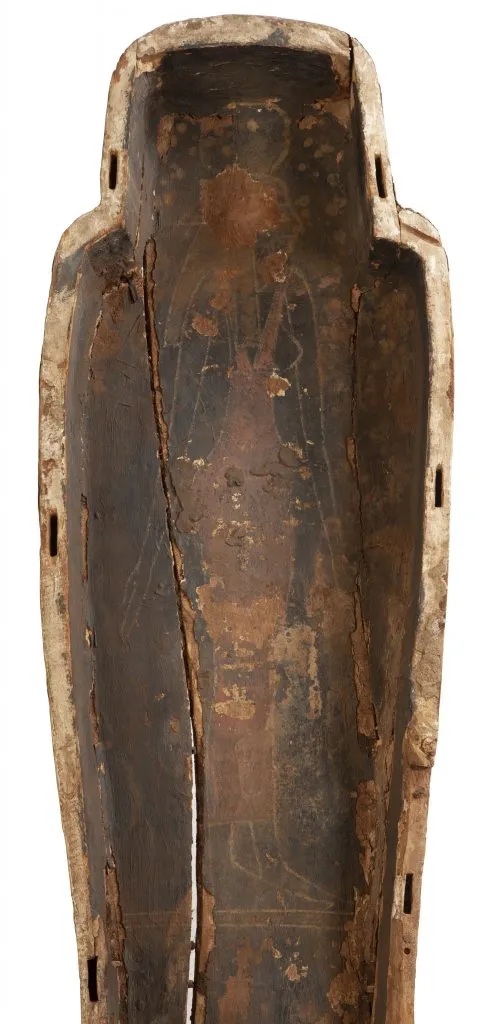Archaeologists Discover Paintings of Goddess in 3,000-Year-Old Mummy’s Coffin
Researchers lifted the ancient Egyptian mummy out of her coffin for the first time in 100 years and, to their surprise, uncovered the ancient artworks
:focal(1881x959:1882x960)/https://tf-cmsv2-smithsonianmag-media.s3.amazonaws.com/filer/e2/a5/e2a58e77-5843-4948-9d37-908e440fa009/perth-mummy-ta-kr-hb-with-dr-mark-hall-and-anna-zwaggerman.jpg)
If you think you haven’t been moving around much lately, consider Ta-Kr-Hb: Until last month, the ancient woman had lain undisturbed in her coffin for more than 100 years. So, when conservators at the Perth Museum and Art Gallery in Scotland lifted the mummy out of her coffin for preservation efforts, they encountered a surprise. Unbeknownst to her caretakers, the 3,000-year-old Egyptian had spent decades resting atop extraordinary painted figures.
The Scottish museum announced its discovery in a statement last month. Conservators have been working to restore the mummy as part of the museum’s “Conservation in Action: Saving the Perth Mummy” exhibition. They plan to display Ta-Kr-Hb at the redeveloped City Hall Museum in 2022.
The two newly discovered paintings line the internal and external bases of the coffin’s lower section, or trough. Of the pair, the best-preserved image is that of Egyptian goddess Amentet or Imentet, also known as “She of the West,” who is seen wearing a red dress. The figure has ribbons draped around her arms and is depicted in profile, with her head facing to the right. The goddess stands on a platform and supporting pole—a pose that has led researchers to suspect the painting is based on a statue, reports Alan Young for the Scotsman.
“We had never had a reason to lift the whole thing so high that we could see the underneath of the trough and had never lifted the mummy out before and didn’t expect to see anything there,” Mark Hall, collections officer at Perth Museum and Art Gallery, tells Young. “So, to get a painting on both surfaces is a real bonus and gives us something extra special to share with visitors.”

The practice of mummification likely began in ancient Egypt around 2600 B.C. It was an expensive process, meaning that pharaohs, officials and nobility were the most likely members of society to be mummified.
A 2013 study conducted by researchers at the University of Manchester’s KNH Centre for Biomedical Egyptology suggested Ta-Kr-Hb was a priestess or princess from Thebes who died during Egypt’s 25th dynasty, which lasted from 747 to 656 B.C.
Per the paper, a man named William Bailey purchased the mummy from a curator at a government museum in Cairo toward the end of the 19th century. In 1896, Bailey donated Ta-Kr-Hb’s remains to the Alloa Society of Natural Science and Archaeology, which, in turn, gifted the mummy and coffin to the Perth Museum in 1936. Ta-Kr-Hb has resided there ever since, according to BBC News.
In a joint statement, conservators Helena and Richard Jaeschke note that the mummy’s past encounters with grave robbers have left it in a very fragile state.
“Although both the mummy and the coffin have suffered badly during the centuries in the tomb, from grave-robbers searching for amulets to flash floods that washed mud and debris onto the painted coffin, they have survived remarkably well,” the conservators add, “and [will] need careful, patient conservation treatment to enable them to survive for many more years.”
/https://tf-cmsv2-smithsonianmag-media.s3.amazonaws.com/accounts/headshot/nora.png)
/https://tf-cmsv2-smithsonianmag-media.s3.amazonaws.com/accounts/headshot/nora.png)